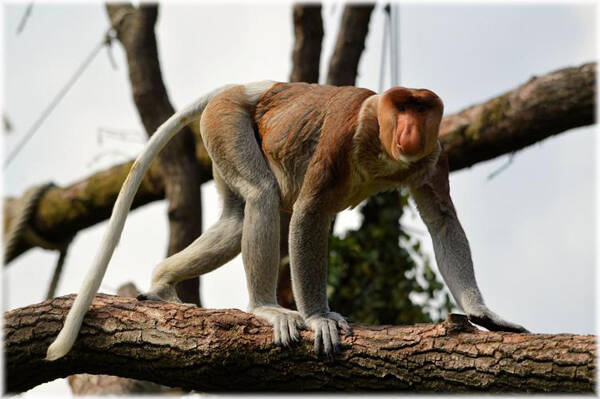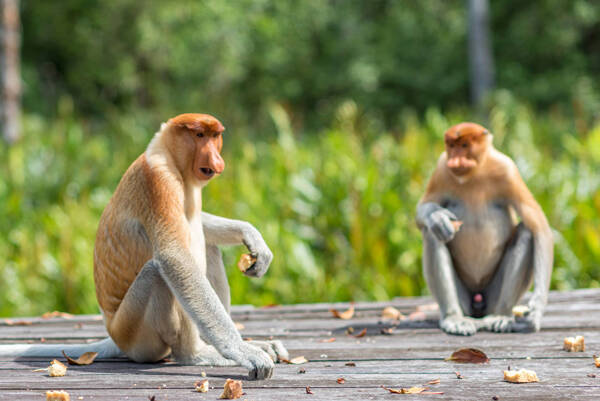Nasalis larvatus
IUCN
LCBasic Information
Scientific classification
- name:Nasalis larvatus
- Scientific Name:Nasalis larvatus,Tengu Monkey
- Outline:Primates
- Family:S.Simius F.Cephalidae S.Colobinae G.P.Monkey
Vital signs
- length:60-72cm
- Weight:7-22kg
- lifetime:About 16 years
Feature
An unusually large nose and a large, pouch-like stomach
Distribution and Habitat
Proboscis monkeys are found in Borneo, Southeast Asia, namely Brunei, Kalimantan in Indonesia, Sarawak and Sabah in Malaysia.
Proboscis monkeys prefer to move from coastal areas to inland areas. They are often found in coastal lowland forests, including mangrove peat swamps and freshwater swamp forests. Proboscis monkeys rarely live far from water sources.
Appearance
Proboscis monkeys weigh 7-22 kg and are 60-70 cm long. Male monkeys are much larger than female monkeys, generally 72 cm long, with a tail length of 78 cm and a weight of 24 kg, while female monkeys are only 60 cm long. Proboscis monkeys have a large abdomen and their digestive system is divided into several parts, which helps them digest leaves. Both hands and feet have 5 fingers and toes, with flat nails that can stand upright. The fur of adult proboscis monkeys is pink and brown; the head and shoulders are red; the arms, legs and tail are gray. Males have black scrotums and red penises. The face of a baby proboscis monkey is blue when it is born, and it turns dark gray at 2-3 months. At 8-9 months, it is the same color as an adult monkey.
The biggest difference between proboscis monkeys and other monkeys is that the nose of an adult male becomes larger and larger as he grows older, and the final length reaches 7-8 cm. Because of the bright red color, from a distance, it looks lik
Details
The proboscis monkey (scientific name: Nasalis larvatus) is a unique animal in Kalimantan, Southeast Asia. It is the only species discovered that is not a ruminant but can regurgitate.

The social groups of proboscis monkeys change much faster than those of most other primates. Every once in a while, the members of a group will undergo some changes.
The change in social group members is partly due to the leader constantly expelling young males who are not yet mature but can live independently. These young males who are expelled from the group will spontaneously gather into a new group, called a "pure male group", which is mostly led by an older male who is still underage, plus more than a dozen young males of similar age. Sometimes people mistakenly think it is a new social group, but in fact, this "pure male group" is extremely unstable, and its members change almost every day. Not only do new young males often join in because they are expelled from the social group, but some also enter other social groups and replace the original leader through competition.
When the young males in each "pure male group" mature, they will challenge the leader of the social group and fight fiercely. If they succeed, a new leader will be born, and it will take over the females and other members of the community. However, if the females in the community do not like the new leader, they may join another community. Sometimes a strange phenomenon will occur. Some females will leave their original social group during the period of nursing their cubs and join the "pure male group". After a few weeks, they will move to other communities.
The motivation for this behavior is not very clear now. One speculation is that the leader of the original social group has been replaced by a new leader. After the new leader occupies this group, sometimes in order to get rid of the offspring of the original competitor, he will kill all the cubs in this community. The females will try their best to protect their young, but it is often very difficult to compete with the strong new leader. In this situation, the females can only accept this cruel reality that cannot be avoided, or leave this social group and take the risk to join a new social group, living with another strange male as the leader, but they may have the same experience. Another safer option is to go to the "pure male group" first and live with young males temporarily, because the males in this temporary group are not yet adults and do not pose a threat to females, but this is just a matter of rights and interests.
Proboscis monkeys live in groups and have a strict community system. Each typical social group will have an adult male as the leader, and 1 to 8 adult females and their offspring together, generally 10 to 30, living together every day. However, some individuals may move around other groups from time to time, and females may move between two groups to avoid inbreeding or to get closer to more food. At night, several groups sometimes gather together to move, rest or sleep, and quarrels and even fights often occur, which is very lively. When an individual in the group is bullied, adult males often roar at the other party with their big noses, and the airflow in the nose will make the drooping nose swell and stand up high.

Proboscis monkeys mainly feed on seeds, mangrove buds and young leaves, and a small amount of fruit, and sometimes eat some invertebrates such as caterpillars and larvae. On the island of Kalimantan, due to the poor soil, the food for the larger proboscis monkeys is not abundant. The leaves of many plants are very rough and cannot be digested at all. Therefore, it is difficult to find edible food in the season when the fruits on the trees are not yet ripe, forcing them to walk several kilometers every day to find enough food.
The proboscis monkey has a large, bag-shaped stomach in its big belly, which is very similar to the stomach of ruminants in anatomy and physiology. There are a large number of microorganisms that can ferment food in the stomach, allowing the proboscis monkey to digest plant leaves containing a lot of cellulose, so it eats more plant species than other primates. In addition, the microorganisms growing in its stomach can also decompose certain toxins. If it eats toxic food, it will be decomposed by microorganisms and become ineffective before being absorbed into the blood.
Proboscis monkeys breed once a year. During the breeding season, males rely mainly on their large noses to please females. The gestation period of females is about 166 days, and only one cub is born per litter. The appearance of the cub is very different from that of the adult individual. The fur of the cub is all black and very sparse. After half a year, it is gradually replaced by ochre-yellow fur. After 7 months, it is weaned, after 12 months, it is independent, and after 7 years, it reaches sexual maturity.
Despite the harsh habitat conditions, the coastal low-lying areas where proboscis monkeys live are still the most densely populated areas on the island of Kalimantan, and are also the most economically developed areas on the island, with the largest towns and most agricultural areas on the island concentrated. In Sarawak and Sabah, the large-scale logging and utilization of coastal mangroves and other forests have seriously destroyed the few remaining proboscis monkey habitats. In some areas, especially in Sarawak, although proboscis monkeys are strictly protected by law, illegal hunting for entertainment purposes is still a serious threat to their extinction. In Sarawak, there are less than 1,000 proboscis monkeys, and they are distributed irregularly; in Sabah, proboscis monkeys only exist in some areas; at the mouth of the Brunei River, only one population is found. In Indonesia, the number of proboscis monkeys has dropped from more than 1,000 to less than 100.
In order to protect this world-famous rare animal and its habitat, a 60-square-kilometer proboscis monkey nature reserve was established in Sarawak in 1977. This is a mixed forest belt near the coast. The Samunsa River runs through the middle of the entire forest. Mangroves surround the estuary and gradually extend to the coastal forests, all the way to the hinterland of Kalimantan Island.
Listed in Appendix I, Appendix II and Appendix III of the Convention on International Trade in Endangered Species of Wild Fauna and Flora (CITES) 2019 Edition
Protect wild animals and eliminate game.
Maintaining ecological balance is everyone's responsibility!








